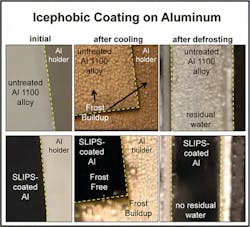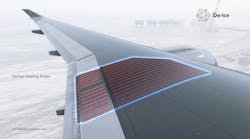The Wall Street Journal reported in the June 22 edition of its Ideas Market blog that Harvard engineers have developed a possible way to repel ice from alumium surfaces exposed to harsh elements.
"Our surfaces remain essentially frost-free in which any conventional materials accumulate ice," the report states. "These results indicate ... a promising candidate for developing robust anti-icing materials for broad applications, such as refrigeration, aviation, roofs, wires, outdoor signs, railings and wind turbines."
Using aircraft deicing as our example, the Journal explains the findings this way:
- A highly porous fabricated surface sits atop the wing. This engineered coating uses nanotechnology to essentially create bumps or fibers.
- Any liquid that doesn't mix with water, such as oil, covers the porous surface.
- The structure of fibers or bumps is what locks the liquid in place.
- The liquid prevents ice from attaching to the wing.
"On the basis of a theoretical analysis followed by extensive icing/deicing experiments ... our surfaces remain essentially frost-free in which any conventional materials accumulate ice," the reports states.
The full report is firewalled, but here's a link to a summary that inlcudes illustrations and video.





